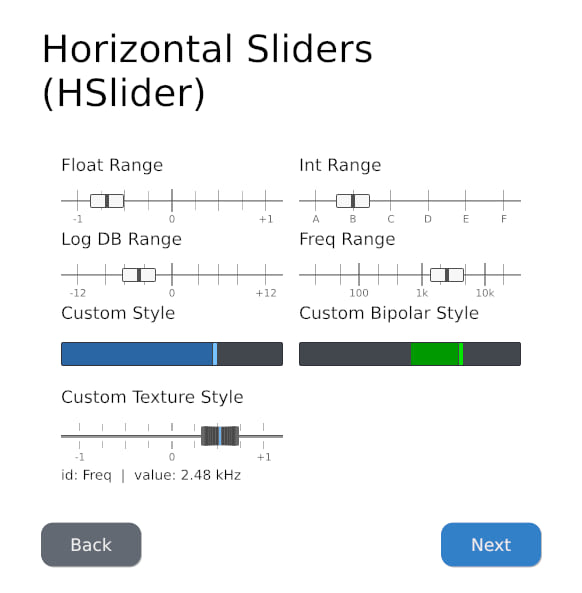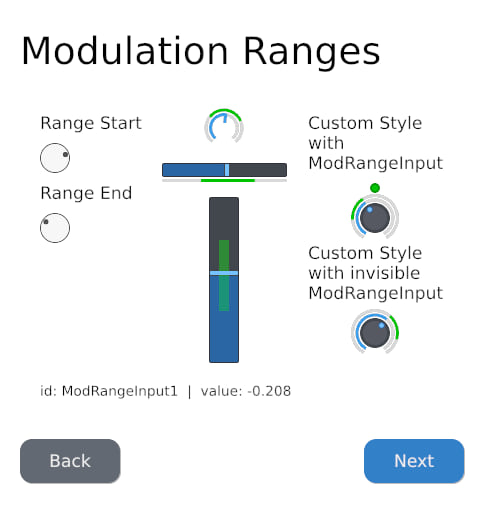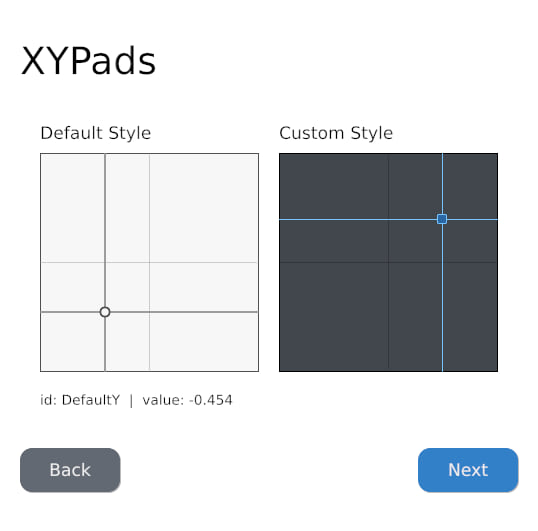39 releases (12 breaking)
| 0.12.0 | Aug 3, 2023 |
|---|---|
| 0.11.0 | Feb 25, 2023 |
| 0.10.0 | Jan 31, 2023 |
| 0.9.0 | Dec 22, 2022 |
| 0.4.0 | Jul 29, 2020 |
#342 in GUI
33 downloads per month
Used in 6 crates
(2 directly)
410KB
9K
SLoC
Iced Audio
An extension to the Iced GUI library with useful widgets for audio applications such as VST / LV2 plugins.



Widgets implemented
Inputs
-
HSlider- Horizontal Slider -
VSlider- Vertical Slider -
Knob- A classic knob widget. (no texture style yet) -
Ramp- Ramp used to control the easing between two points in time -
XYPad- XY Pad for controlling two parameters at once -
ModRangeInput- A dot used to control the range of modulation for a parameter. Styles that add visual feedback of the modulation range exist for theHSlider,VSlider, andKnobwidgets.
Take a look at the roadmap for a list of planned widgets.
Each parameter can be mapped to one of four ranges:
FloatRange- a linear range of f32 valuesIntRange- a discrete range of i32 values. This will cause the widget to "step" when moved.LogDBRange- a logarithmic range of decibel values. Values around 0 dB will increment slower than values farther away from 0 dB.FreqRange- a logarithmic range of frequency values. Each octave in the 10 octave spectrum (from 20 Hz to 20480 Hz) is spaced evenly.
Run examples with
cargo run --package inputs_tour --release
cargo run --package simple --release
Installation
Add iced_audio as a dependency in your Cargo.toml:
iced_audio = "0.8"
Or if you want to use the GitHub version of iced:
iced_audio = { git = "https://github.com/iced-rs/iced_audio", branch = "iced_git" }
Both Iced Audio and Iced move fast and the main and iced_git branch can contain breaking changes! If
you want to learn about a specific release, check out the release list.
Simple Usage Example
This crate assumes you know the basics of how to use Iced. If you haven't already, please check it out here.
// Import iced modules.
use iced::widget::{column, container, text};
use iced::{Alignment, Element, Length, Sandbox, Settings};
// Import iced_audio modules.
use iced_audio::{
tick_marks, FloatRange, FreqRange, HSlider, IntRange, Knob, LogDBRange,
Normal, NormalParam, VSlider, XYPad,
};
// The message when a parameter widget is moved by the user
#[derive(Debug, Clone)]
pub enum Message {
HSliderInt(Normal),
VSliderDB(Normal),
KnobFreq(Normal),
XYPadFloat(Normal, Normal),
}
pub fn main() {
App::run(Settings::default()).unwrap();
}
pub struct App {
// The ranges handle converting the input/output of a parameter to and from
// a usable value.
//
// There are 4 built-in options available for a range:
//
// * FloatRange - a linear range of f32 values
// * IntRange - a discrete range of i32 values. This will cause the widget
// to "step" when moved.
// * LogDBRange - a logarithmic range of decibel values. Values around 0 dB
// will increment slower than values farther away from 0 dB.
// * FreqRange - a logarithmic range of frequency values. Each octave in
// the 10 octave spectrum (from 20 Hz to 20480 Hz) is spaced evenly.
//
float_range: FloatRange,
int_range: IntRange,
db_range: LogDBRange,
freq_range: FreqRange,
// The states of the widgets that will control the parameters.
h_slider_param: NormalParam,
v_slider_param: NormalParam,
knob_param: NormalParam,
xy_pad_x_param: NormalParam,
xy_pad_y_param: NormalParam,
// A group of tick marks with their size and position.
center_tick_mark: tick_marks::Group,
output_text: String,
}
impl Sandbox for App {
type Message = Message;
fn new() -> App {
// Initalize each range:
let float_range = FloatRange::default_bipolar();
let int_range = IntRange::new(0, 10);
let db_range = LogDBRange::new(-12.0, 12.0, 0.5.into());
let freq_range = FreqRange::default();
App {
// Add the ranges.
float_range,
int_range,
db_range,
freq_range,
// Initialize the state of the widgets with a normalized parameter
// that has a value and a default value.
h_slider_param: int_range.normal_param(5, 5),
v_slider_param: db_range.default_normal_param(),
knob_param: freq_range.normal_param(1000.0, 1000.0),
xy_pad_x_param: float_range.default_normal_param(),
xy_pad_y_param: float_range.default_normal_param(),
// Add a tick mark at the center position with the tier 2 size
center_tick_mark: tick_marks::Group::center(tick_marks::Tier::Two),
output_text: "Move a widget!".into(),
}
}
fn title(&self) -> String {
format!("Simple Example - Iced Audio")
}
fn update(&mut self, event: Message) {
match event {
// Retrieve the value by mapping the normalized value of the parameter
// to the corresponding range.
//
// Now do something useful with that value!
Message::HSliderInt(normal) => {
// Integer parameters must be snapped to make the widget "step" when moved.
self.h_slider_param.update(self.int_range.snapped(normal));
let value = self.int_range.unmap_to_value(normal);
self.output_text = format!("HSliderInt: {}", value);
}
Message::VSliderDB(normal) => {
self.v_slider_param.update(normal);
let value = self.db_range.unmap_to_value(normal);
self.output_text = format!("VSliderDB: {:.3}", value);
}
Message::KnobFreq(normal) => {
self.knob_param.update(normal);
let value = self.freq_range.unmap_to_value(normal);
self.output_text = format!("KnobFreq: {:.2}", value);
}
Message::XYPadFloat(normal_x, normal_y) => {
self.xy_pad_x_param.update(normal_x);
self.xy_pad_y_param.update(normal_y);
let value_x = self.float_range.unmap_to_value(normal_x);
let value_y = self.float_range.unmap_to_value(normal_y);
self.output_text =
format!("XYPadFloat: x: {:.2}, y: {:.2}", value_x, value_y);
}
}
}
fn view(&self) -> Element<Message> {
// Create each parameter widget, passing in the current state of the widget.
let h_slider_widget =
HSlider::new(self.h_slider_param, Message::HSliderInt)
// Add the tick mark group to this widget.
.tick_marks(&self.center_tick_mark);
let v_slider_widget =
VSlider::new(self.v_slider_param, Message::VSliderDB)
.tick_marks(&self.center_tick_mark);
let knob_widget =
Knob::new(self.knob_param, Message::KnobFreq, || None, || None);
let xy_pad_widget = XYPad::new(
self.xy_pad_x_param,
self.xy_pad_y_param,
Message::XYPadFloat,
);
// Push the widgets into the iced DOM
let content = column![
h_slider_widget,
v_slider_widget,
knob_widget,
xy_pad_widget,
container(text(&self.output_text)).width(Length::Fill),
]
.max_width(300)
.spacing(20)
.padding(20)
.align_items(Alignment::Center);
container(content)
.max_height(500)
.width(Length::Fill)
.height(Length::Fill)
.center_x()
.center_y()
.into()
}
}
VST / LV2 / AU Plugins
If you wish to use iced_audio for audio plugins, check out my other repos.
Please note these are experimental and currently lacking many features.
iced_baseview- Run Iced usingbaseviewas a backend.iced-baseplug-examples- Example audio plugins usingbaseplugas a plugin wrapper,iced_baseviewas a GUI backend, and iced_audio widgets.
Contributing / Feedback
Contributions are greatly appreciated! If you want to contribute, please read the official Iced contributing guidelines for more details.
Feedback is also welcome! You can open an issue or, if you want to talk,
come chat to our Discord server. Moreover, you can find me (and a bunch of
awesome folks) over the #gui-and-ui channels in
the Rust Community Discord. I go by BillyDM#3892 there.
Dependencies
~12–43MB
~751K SLoC